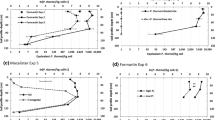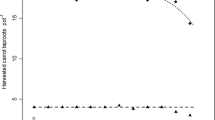Abstract
Pratylenchus thornei is a major pathogen of wheat in Australia. Two glasshouse experiments with four wheat cultivars that had different final populations (Pf) of P. thornei in the field were used to optimise conditions for assessing resistance. With different initial populations (Pi) ranging up to 5250 P. thornei/kg soil, Pf of P. thornei increased to 16 weeks after sowing, and then decreased at 20 weeks in some cultivar x Pi combinations. The population dynamics of P. thornei up to 16 weeks were best described by a modified exponential equation P f (t) = aP i e kt where P f (t) is the final population density at time t, P i is the initial population density, a is the proportion of P i that initiates population development, and k is the intrinsic rate of increase of the population. The cultivar GS50a had very low k values at Pi of 5250 and 1050 indicating its resistance, Suneca and Potam had high k values indicating susceptibility, whereas intolerant Gatcher had a low value at the higher Pi and a high value at the lower Pi. Nitrate fertiliser increased plant growth and Pf values of susceptible cultivars, but in unplanted soil it decreased Pf. Nematicide (aldicarb 5 mg/kg soil) killed P. thornei more effectively in planted than in unplanted soil and increased plant growth particularly in the presence of N fertiliser. In both experiments, the wheat cultivars Suneca and Potam were more susceptible than the cultivar GS50a reflecting field results. The method chosen to discriminate wheat cultivars was to assess Pf after growth for 16 weeks in soil with Pi ~1050–5250 P. thornei/kg soil and fertilised with 200 mg NO3–N/kg soil.








Similar content being viewed by others
References
Baxter RI, Blake CD (1967) Invasion of wheat roots by Pratylenchus thornei. Nature 215:1168–1169
Beckman CG, Thompson CH (1960) Soils and land use in the Kurrawa area, Darling Downs, Queensland. CSIRO Soils and Land Use Series, No. 37 CSIRO, Melbourne
Castillo P, Vovlas N (2007) Pratylenchus (Nematoda: Pratylenchidae): Diagnosis, biology, pathogenicity and management. Chap 7. Biology and ecology of Pratylenchus. Nematol Monographs Perspectives 6, Hunt DJ, Perry RN (series Eds) Brill, Leden-Boston, 305–324.
De Waele D, Elsen A (2002) Migratory endoparasites: Pratylenchus and Radopholus species. Chap 8. In: Starr JL, Cook R, Bridge J (eds) Plant resistance to parasitic nematodes. CABI Publishing, Wallingford, pp. 175–206
FAO (1998) World reference base for soil resources. World Soil Resource Report No. 84. Food and Agriculture Organisation, Rome
Fortuner R (1977) Pratylenchus thornei. C.I.H. Description of Plant-parasitic Nematodes Set 7, No. 93. (Commonwealth Institute of Helminthology: St Albans, UK)
GraphPad Prism (2012) Version 6.00 for Windows, GraphPad Software, San Diego, CA, USA. www.graphpad.com
Hodda M, Collins SJ, Vanstone VA, Hartley D, Wanjura W, Kehoe M (2014) Pratylenchus quasiterioides n. sp. from cereals in Western Australia. Zootaxa 3866:277–288
Isbell RF (1996) The Australian soil classification, Revised edn. CSIRO Publishing, Melbourne
Kimpinski J, Wallace HR, Cunningham RB (1976) Influence of some environmental factors on populations of Pratylenchus minyus in wheat. J Nematol 8:309–314
Larson JE (1959) The biology of Pratylenchus thornei Sher and Allen, 1953. Ph. D. thesis, Entomology Department, University of California. 123 pp
Linsell KJ, Riley IT, Davies KA, Oldach KH (2014) Characterization of resistance to Pratylenchus thornei (nematoda) in wheat (Triticum aestivum): attraction, penetration, motility, and reproduction. Phytopathology 104:174–187
McSorley R (1998) Population dynamics. Chap 6. In: Barker KR, Pederson GA, Windham GL (Eds) Plant and nematode interactions. American Society of Agronomy, Number 36 in series Agronomy, Crop Science Society of America and Soil Science Society of America: Madison, pp. 109–132
O’Brien PC (1982) A study on the host range of Pratylenchus thornei. Australas Plant Pathol 11:3–5
Roberts PA (2002) Concepts and consequences of resistance. Chap 2. In: Starr JL, Cook R, Bridge J (eds) Plant resistance to parasitic nematodes. CABI Publishing, Wallingford, pp. 23–41
Seinhorst JW (1966) The relationships between population increase and population density in plant parasitic nematodes I. Introduction and migratory nematodes. Nematologica 12:157–169
Seinhorst JW (1967) The relationships between population increase and population density in plant parasitic nematodes. V Influence of damage to the host on multiplication. Nematologica 13:31–492
Smiley RW, Nicol JM (2009) Nematodes which challenge global wheat production. Chap 8. In: Carver BF (ed) Wheat Science and Trade. Wiley-Blackwell, Ames, Iowa, pp. 171–187
Thompson JP (1987a) Decline of vesicular‑arbuscular mycorrhizae in long fallow disorder of field crops and its expression in phosphorus deficiency of sunflower. Aust J Agric Res 38:847–867
Thompson JP (1987b) Effects of root lesion nematode (Pratylenchus thornei) on nitrogen nutrition of wheat, International Symposium on Advances in Nitrogen Cycling in Agricultural Ecosystems, Poster Abstracts, pp 163–165. (CSIRO, Brisbane)
Thompson JP (1990) Treatments to eliminate root‑lesion nematode (Pratylenchus thornei Sher and Allen) from a vertisol. Nematologica 36:123–127
Thompson JP, Owen KJ, Stirling GR, Bell MJ (2008) Root-lesion nematodes (Pratylenchus thornei and P. neglectus): a review of recent progress in managing a significant pest of grain crops in northern Australia. Australas Plant Pathol 37:235–242
Thompson JP, Clewett TG, Sheedy JG, Reen RA, O’Reilly MM (2010) Occurrence of root-lesion nematodes (Pratylenchus thornei and P. neglectus) and stunt nematode (Merlinius brevidens) in the northern grain production region of Australia. Australas Plant Pathol 39:254–264
Thompson JP, Mackenzie J, Sheedy GH (2012) Root-lesion nematode (Pratylenchus thornei) reduces nutrient response, biomass and yield of wheat in sorghum–fallow–wheat cropping systems in a subtropical environment. Field Crop Res 137:126–140
Townshend JL (1972) Influence of edaphic factors on penetration of corn roots by Pratylenchus penetrans and P. minyus in three Ontario soils. Nematologica 18:201–212
Townshend JL (1978) Infectivity of Pratylenchus penetrans on alfalfa. J Nematol 10:318–322
Townshend JL, Wolynetz MS (1991) Penetration of celery and alfalfa roots by Pratylenchus penetrans as affected by temperature. J Nematol 23:194–197
Trudgill DL (1991) Resistance to and tolerance of plant parasitic nematodes in plants. Annu Rev Phytopathol 29:167–192
Trudgill DL, Phillips MS (1997) Nematode population dynamics, threshold levels and estimation of crop losses. In: Maqbool MA, Kerry BR (Eds) Plant Nematode problems and their control in the near east region. FAO Plant Prod. Prot. Pap. 144, Rome, pp. 45–58
Umesh KC, Ferris H (1992) Effects of temperature on Pratylenchus neglectus and on its pathogenicity to barley. J Nematol 24:504–511
Van der Plank JE (1968) Disease resistance in plants. Academic Press, New York, p. 206
Vanstone VA, Hollaway GJ, Stirling GR (2008) Managing nematode pests in the southern and western regions of the Australian cereal industry: continuing progress in a challenging environment. Australas Plant Pathol 37:220–224
VSN International (2012) GenStat for Windows, Fourteenth ed. VSN International: Hemel Hempstead, UK. Web page: GenStat.Co.UK
Walker JT (1971) Populations of Pratylenchus penetrans relative to decomposing nitrogenous soil amendments. J Nematol 3:43–49
Webb AA, Grundy MJ, Powell B, Littleboy M (1997) The Australian subtropical cereal belt: Soils, climate and agriculture. In: Clarke AL, Wylie PB (eds) ‘Sustainable crop production in the sub-tropics – an Australian perspective’. Queensland Department of Primary Industries, Toowoomba, pp. 8–23
Whitehead AG, Hemming JR (1965) A comparison of some quantitative methods of extracting small vermiform nematodes from soil. Ann Appl Biol 55:25–38
Young LD (1998) Breeding for nematode resistance and tolerance. Chap 10. In: Barker KR, Pederson GA, Windham GL (Eds) Plant and nematode interactions. American Society of Agronomy, Number 36 in series Agronomy, Crop Science Society of America and Soil Science Society of America: Madison, pp. 187–207
Zadoks JC, Chang TT, Konzak CF (1974) A decimal code for the growth stages of cereals. Weed Res 14:415–421
Acknowledgments
We thank the Grains Research and Development Corporation (GRDC) for funding and Kerry Bell for advice on statistical analyses.
Author information
Authors and Affiliations
Corresponding author
Electronic supplementary materials
Electronic supplementary materials
Accessory Table 1
(DOCX 20 kb)
Accessory Table 2
(DOCX 19 kb)
Accessory Table 3
(DOCX 18 kb)
Rights and permissions
About this article
Cite this article
Thompson, J.P., Clewett, T.G. & O’Reilly, M.M. Optimising initial population density, growth time and nitrogen nutrition for assessing resistance of wheat cultivars to root-lesion nematode (Pratylenchus thornei). Australasian Plant Pathol. 44, 133–147 (2015). https://doi.org/10.1007/s13313-015-0347-6
Received:
Accepted:
Published:
Issue Date:
DOI: https://doi.org/10.1007/s13313-015-0347-6




